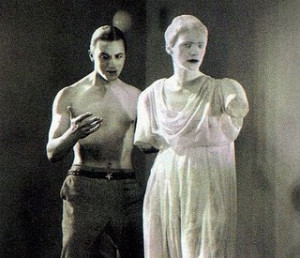 In his dreamlike debut film from 1930 called The Blood of a Poet, Jean Cocteau, already famous for his provocative, experimental work in the drama, ballet, and visual arts, explored his lifelong theme—the struggle of the artist to realize his calling.
In his dreamlike debut film from 1930 called The Blood of a Poet, Jean Cocteau, already famous for his provocative, experimental work in the drama, ballet, and visual arts, explored his lifelong theme—the struggle of the artist to realize his calling.
We see a young man (his powdered wig indicates the 18th century) cover the mouth on a portrait he is painting when someone comes into the room. After the visitor leaves, the artist discovers, to his dismay, that the mouth of the portrait has transferred itself to his hand, and no amount of shaking or washing of the hand will get rid of it. The next day he manages to wipe the mouth onto a statue, which then says to him, “Do you think it’s that simple to close the mouth of a wound?” The only way to get out of the room, at this point, is to jump through a mirror, after which he finds himself in a hallway where he peeks through the keyholes of doors to witness a series of enigmatic scenes.
A second episode concerns a group of schoolboys having a snowball fight, in which one of them is felled and lies bleeding from the mouth. The theme is cruelty. A third episode expands this idea into the social realm, with a rich couple playing cards on a table that is standing on the boy’s body. They are indifferent to the suffering around them, and the spectacle is applauded by other aristocratic figures watching from a balcony. After a sequence in which a black angel comes to rescue the soul of the fallen boy, the woman card player wins, slaying her opponent, and turning into a kind of Muse figure. The film ends with a series of tableaux in which the Muse takes on an increasingly abstract and mystical character. The framing device for the picture is the collapse of a huge factory chimney. We are to understand that the entire process outlined in the film took place during the few moments in which this chimney falls to the ground.
Many critics and viewers, then and now, have considered the film surrealistic because of its lack of conventional narrative coherence and its strange imagery. But properly speaking, the film is symbolist, not surrealist. Every sequence has a meaning, and a place within the larger symbolic sequence of the film. It’s clear that the theme of the mouth, for instance, has to do with a man’s discovery of his own artistic impulses, and the resistance and conflict he feels about this discovery, which is experienced almost as an imposition by an unknown higher force.
Cocteau hadn’t mastered the art of cinema yet in this early film, but it is a remarkable achievement. Watching this movie, you can sense the untapped potential for a cinema of poetic symbolism. With the advent of sound, it seemed as if dramatic narrative was the only acceptable form for a film to take, and that situation has remained unchanged to this day, with the poetry film surviving only in the marginal realm of the avant-garde. Cocteau was one of the few who kept trying. An artist could still learn a great deal about the creative process, and how to challenge himself to think differently, just by studying this one film, The Blood of a Poet.

